Management Accounting Report for Aon Consulting and Sewport Analysis
VerifiedAdded on 2021/02/20
|23
|4715
|364
Report
AI Summary
This report delves into the core concepts of management accounting, focusing on its application within Aon Consulting, a consultancy firm, and its client, Sewport, a designer clothing producer. The introduction establishes the role of management accounting in providing crucial insights for internal decision-making. Task 1 explores various management accounting systems, including cost accounting, inventory management, job costing, and price optimization, highlighting their benefits. It also examines different types of useful reports, such as management accounting reports, account receivable reports, budget reports, inventory management reports, and performance reports. Task 2 focuses on costing techniques, like cost-volume-profit analysis, flexible budgeting, cost variances, and marginal costing, used to prepare income statements and analyze financial performance. The report discusses the importance of these techniques in understanding and controlling costs, ultimately contributing to improved financial outcomes. Finally, the report concludes by summarizing the key findings and emphasizing the significance of management accounting in addressing financial issues and achieving organizational goals.
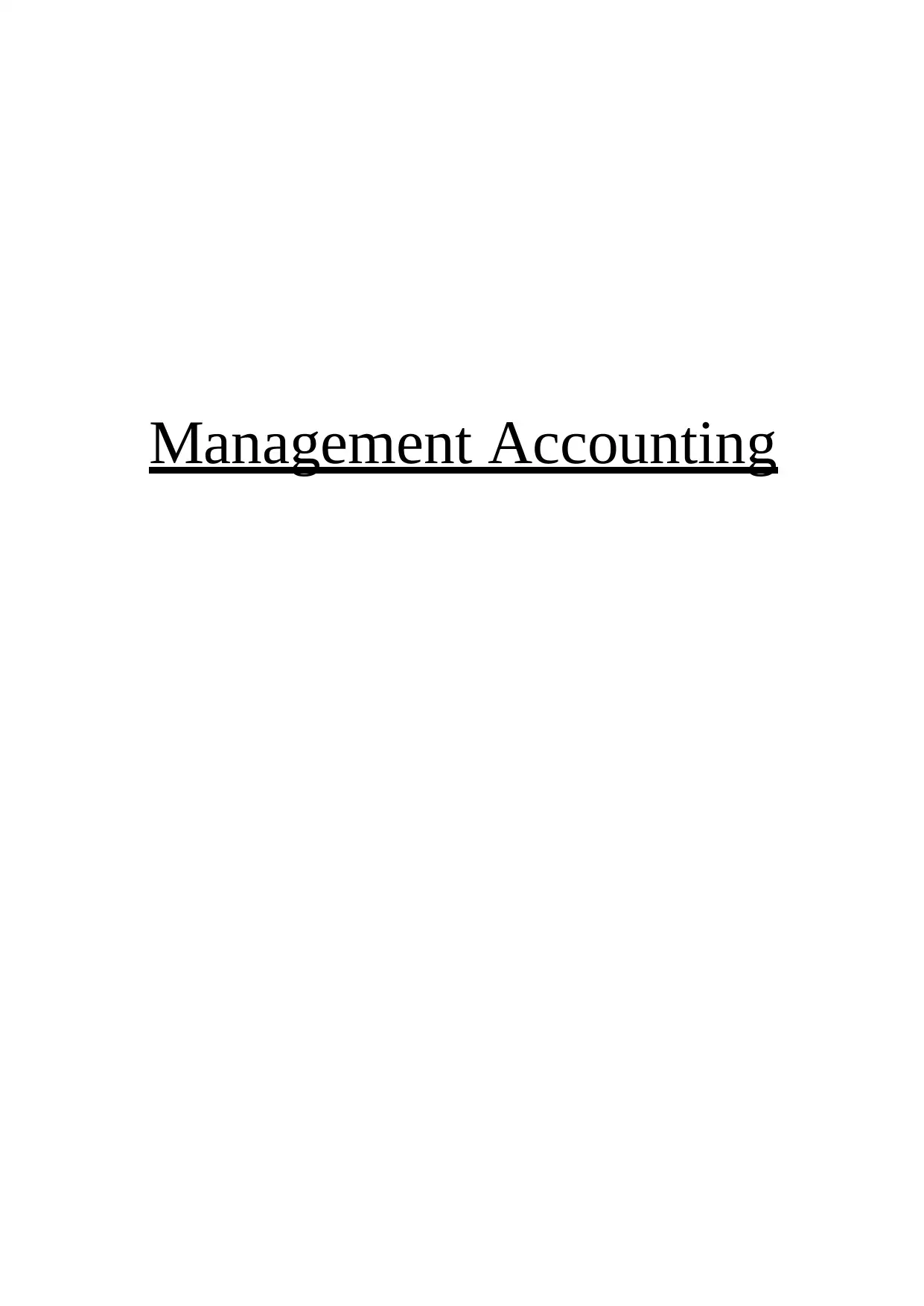
Management Accounting
Paraphrase This Document
Need a fresh take? Get an instant paraphrase of this document with our AI Paraphraser

Table of Contents
INTRODUCTION...........................................................................................................................1
TASK 1............................................................................................................................................1
P1Management accounting and different types of management accounting systems...........1
P2 Various types of useful reports..........................................................................................3
TASK 2............................................................................................................................................5
P3 Costing Techniques to prepare income statements...........................................................5
TASK 3..........................................................................................................................................10
P4 Advantages and disadvantage of different planning tool................................................10
TASK 4..........................................................................................................................................14
P5 Management accounting in response to overcome financial issues................................14
CONCLUSION..............................................................................................................................15
REFRENCES.................................................................................................................................17
INTRODUCTION...........................................................................................................................1
TASK 1............................................................................................................................................1
P1Management accounting and different types of management accounting systems...........1
P2 Various types of useful reports..........................................................................................3
TASK 2............................................................................................................................................5
P3 Costing Techniques to prepare income statements...........................................................5
TASK 3..........................................................................................................................................10
P4 Advantages and disadvantage of different planning tool................................................10
TASK 4..........................................................................................................................................14
P5 Management accounting in response to overcome financial issues................................14
CONCLUSION..............................................................................................................................15
REFRENCES.................................................................................................................................17
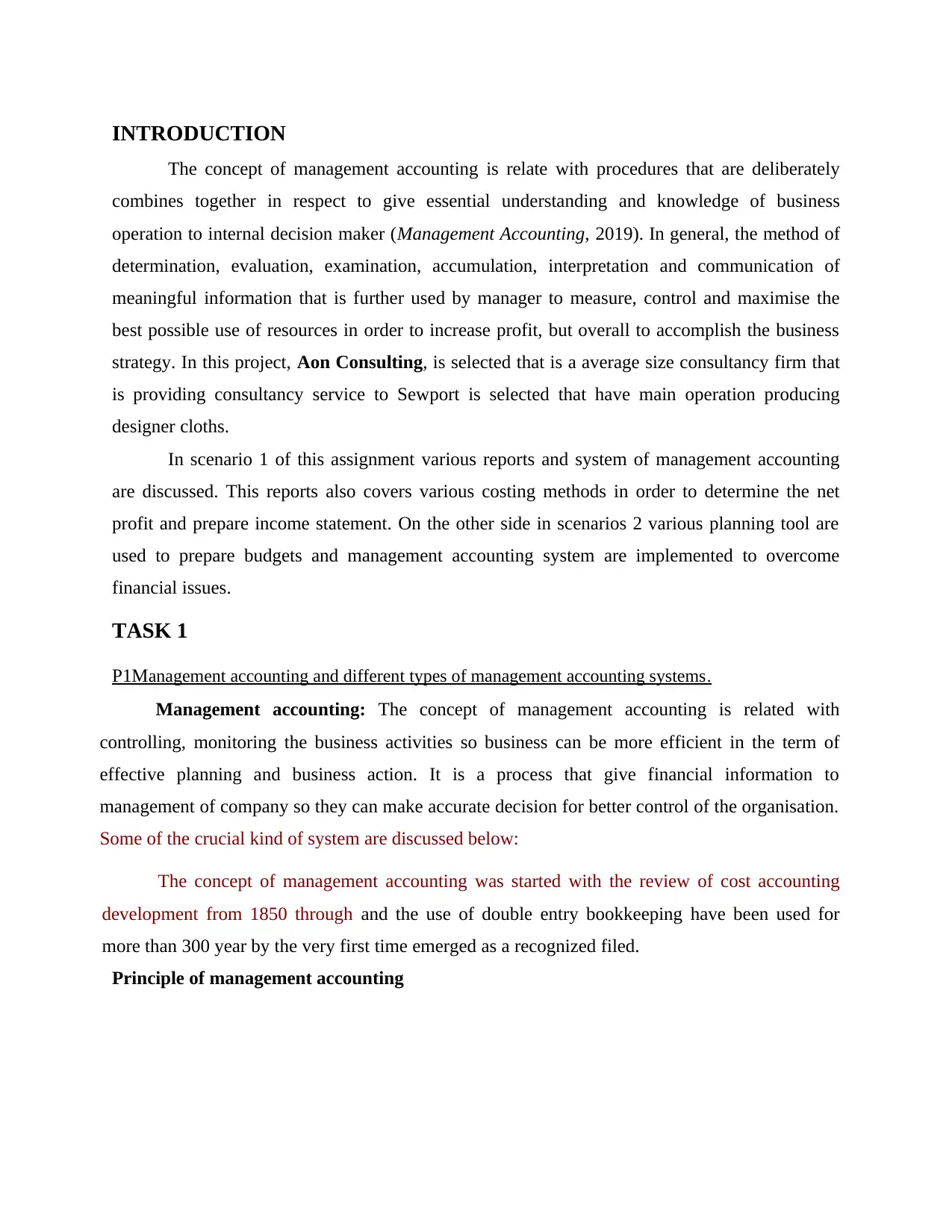
INTRODUCTION
The concept of management accounting is relate with procedures that are deliberately
combines together in respect to give essential understanding and knowledge of business
operation to internal decision maker (Management Accounting, 2019). In general, the method of
determination, evaluation, examination, accumulation, interpretation and communication of
meaningful information that is further used by manager to measure, control and maximise the
best possible use of resources in order to increase profit, but overall to accomplish the business
strategy. In this project, Aon Consulting, is selected that is a average size consultancy firm that
is providing consultancy service to Sewport is selected that have main operation producing
designer cloths.
In scenario 1 of this assignment various reports and system of management accounting
are discussed. This reports also covers various costing methods in order to determine the net
profit and prepare income statement. On the other side in scenarios 2 various planning tool are
used to prepare budgets and management accounting system are implemented to overcome
financial issues.
TASK 1
P1Management accounting and different types of management accounting systems.
Management accounting: The concept of management accounting is related with
controlling, monitoring the business activities so business can be more efficient in the term of
effective planning and business action. It is a process that give financial information to
management of company so they can make accurate decision for better control of the organisation.
Some of the crucial kind of system are discussed below:
The concept of management accounting was started with the review of cost accounting
development from 1850 through and the use of double entry bookkeeping have been used for
more than 300 year by the very first time emerged as a recognized filed.
Principle of management accounting
The concept of management accounting is relate with procedures that are deliberately
combines together in respect to give essential understanding and knowledge of business
operation to internal decision maker (Management Accounting, 2019). In general, the method of
determination, evaluation, examination, accumulation, interpretation and communication of
meaningful information that is further used by manager to measure, control and maximise the
best possible use of resources in order to increase profit, but overall to accomplish the business
strategy. In this project, Aon Consulting, is selected that is a average size consultancy firm that
is providing consultancy service to Sewport is selected that have main operation producing
designer cloths.
In scenario 1 of this assignment various reports and system of management accounting
are discussed. This reports also covers various costing methods in order to determine the net
profit and prepare income statement. On the other side in scenarios 2 various planning tool are
used to prepare budgets and management accounting system are implemented to overcome
financial issues.
TASK 1
P1Management accounting and different types of management accounting systems.
Management accounting: The concept of management accounting is related with
controlling, monitoring the business activities so business can be more efficient in the term of
effective planning and business action. It is a process that give financial information to
management of company so they can make accurate decision for better control of the organisation.
Some of the crucial kind of system are discussed below:
The concept of management accounting was started with the review of cost accounting
development from 1850 through and the use of double entry bookkeeping have been used for
more than 300 year by the very first time emerged as a recognized filed.
Principle of management accounting
⊘ This is a preview!⊘
Do you want full access?
Subscribe today to unlock all pages.

Trusted by 1+ million students worldwide
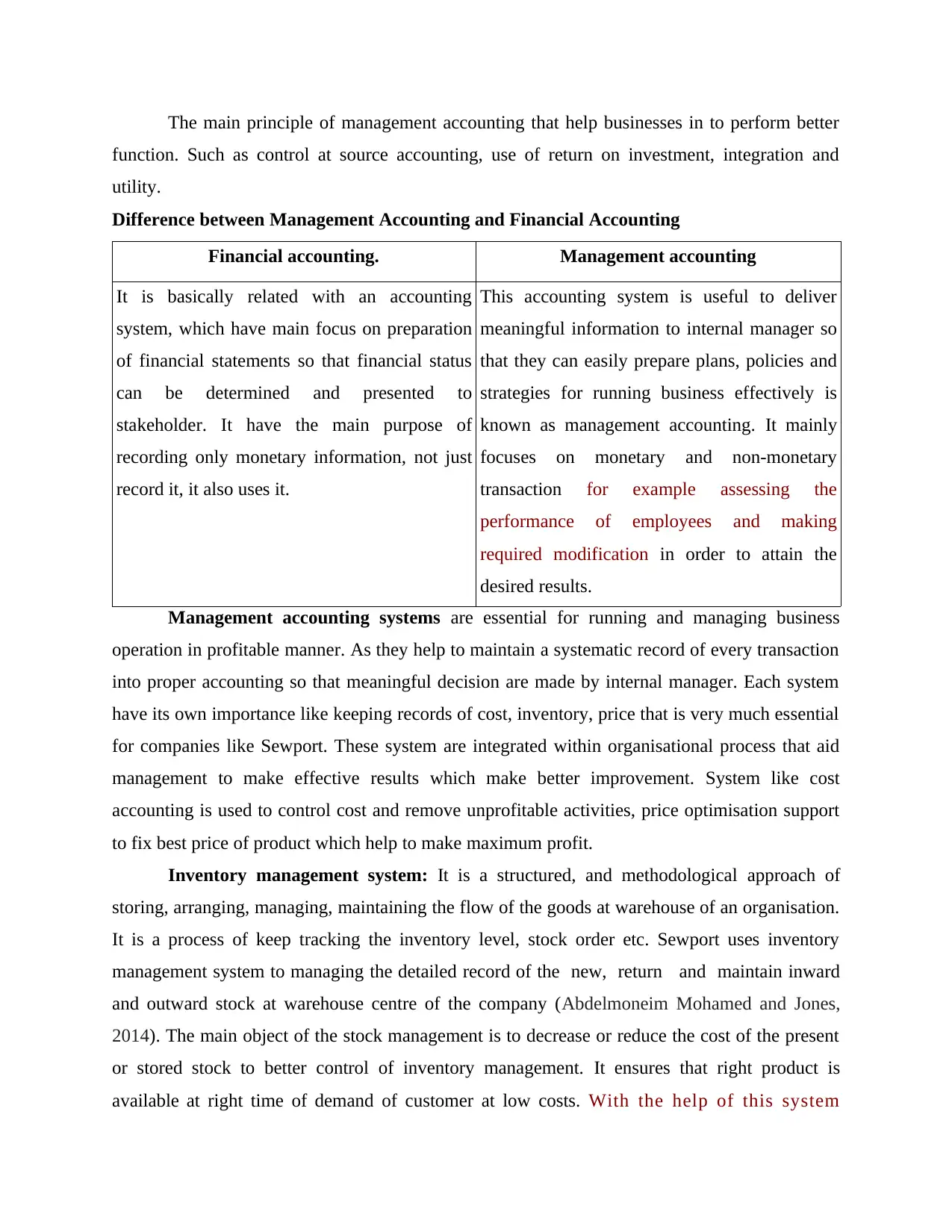
The main principle of management accounting that help businesses in to perform better
function. Such as control at source accounting, use of return on investment, integration and
utility.
Difference between Management Accounting and Financial Accounting
Financial accounting. Management accounting
It is basically related with an accounting
system, which have main focus on preparation
of financial statements so that financial status
can be determined and presented to
stakeholder. It have the main purpose of
recording only monetary information, not just
record it, it also uses it.
This accounting system is useful to deliver
meaningful information to internal manager so
that they can easily prepare plans, policies and
strategies for running business effectively is
known as management accounting. It mainly
focuses on monetary and non-monetary
transaction for example assessing the
performance of employees and making
required modification in order to attain the
desired results.
Management accounting systems are essential for running and managing business
operation in profitable manner. As they help to maintain a systematic record of every transaction
into proper accounting so that meaningful decision are made by internal manager. Each system
have its own importance like keeping records of cost, inventory, price that is very much essential
for companies like Sewport. These system are integrated within organisational process that aid
management to make effective results which make better improvement. System like cost
accounting is used to control cost and remove unprofitable activities, price optimisation support
to fix best price of product which help to make maximum profit.
Inventory management system: It is a structured, and methodological approach of
storing, arranging, managing, maintaining the flow of the goods at warehouse of an organisation.
It is a process of keep tracking the inventory level, stock order etc. Sewport uses inventory
management system to managing the detailed record of the new, return and maintain inward
and outward stock at warehouse centre of the company (Abdelmoneim Mohamed and Jones,
2014). The main object of the stock management is to decrease or reduce the cost of the present
or stored stock to better control of inventory management. It ensures that right product is
available at right time of demand of customer at low costs. With the help of this system
function. Such as control at source accounting, use of return on investment, integration and
utility.
Difference between Management Accounting and Financial Accounting
Financial accounting. Management accounting
It is basically related with an accounting
system, which have main focus on preparation
of financial statements so that financial status
can be determined and presented to
stakeholder. It have the main purpose of
recording only monetary information, not just
record it, it also uses it.
This accounting system is useful to deliver
meaningful information to internal manager so
that they can easily prepare plans, policies and
strategies for running business effectively is
known as management accounting. It mainly
focuses on monetary and non-monetary
transaction for example assessing the
performance of employees and making
required modification in order to attain the
desired results.
Management accounting systems are essential for running and managing business
operation in profitable manner. As they help to maintain a systematic record of every transaction
into proper accounting so that meaningful decision are made by internal manager. Each system
have its own importance like keeping records of cost, inventory, price that is very much essential
for companies like Sewport. These system are integrated within organisational process that aid
management to make effective results which make better improvement. System like cost
accounting is used to control cost and remove unprofitable activities, price optimisation support
to fix best price of product which help to make maximum profit.
Inventory management system: It is a structured, and methodological approach of
storing, arranging, managing, maintaining the flow of the goods at warehouse of an organisation.
It is a process of keep tracking the inventory level, stock order etc. Sewport uses inventory
management system to managing the detailed record of the new, return and maintain inward
and outward stock at warehouse centre of the company (Abdelmoneim Mohamed and Jones,
2014). The main object of the stock management is to decrease or reduce the cost of the present
or stored stock to better control of inventory management. It ensures that right product is
available at right time of demand of customer at low costs. With the help of this system
Paraphrase This Document
Need a fresh take? Get an instant paraphrase of this document with our AI Paraphraser
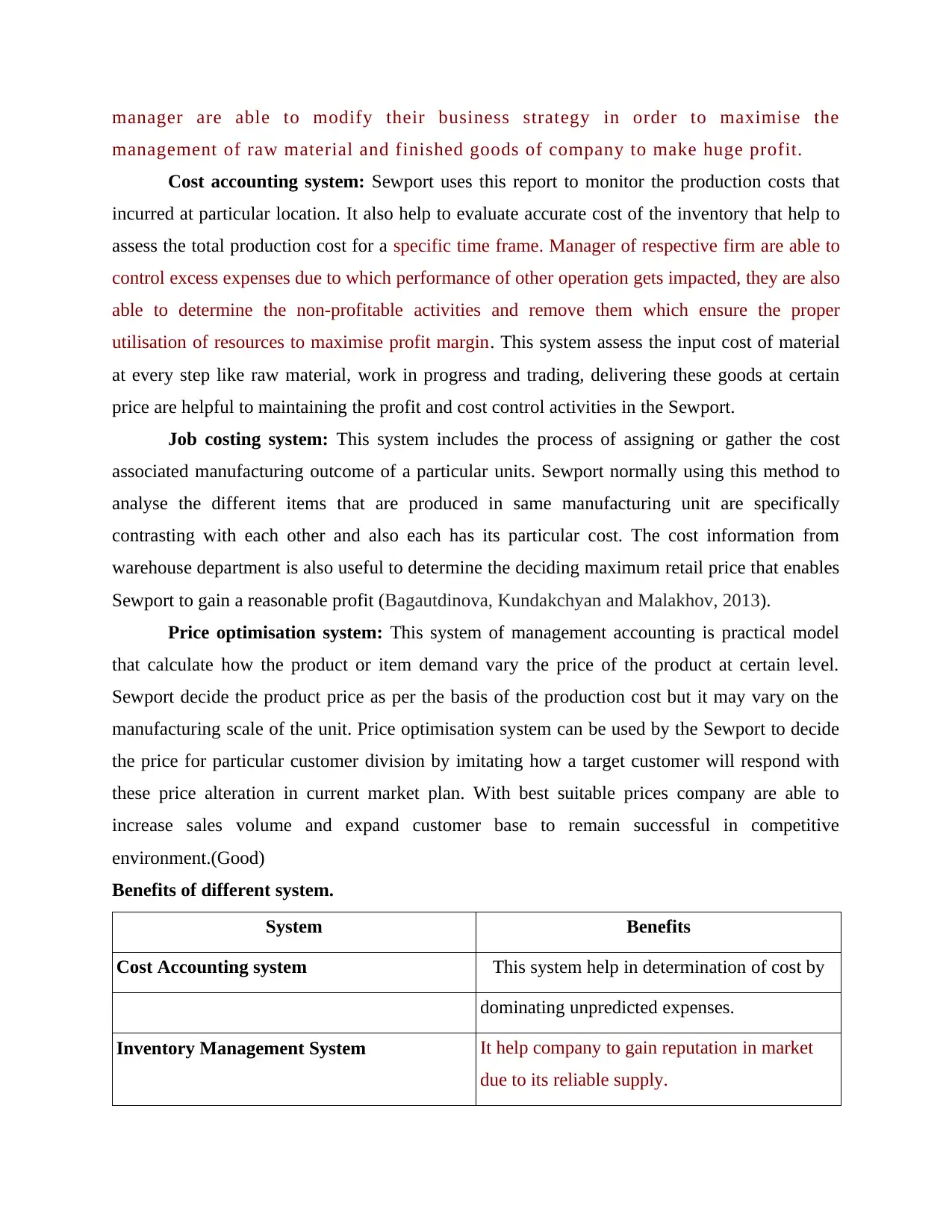
manager are able to modify their business strategy in order to maximise the
management of raw material and finished goods of company to make huge profit.
Cost accounting system: Sewport uses this report to monitor the production costs that
incurred at particular location. It also help to evaluate accurate cost of the inventory that help to
assess the total production cost for a specific time frame. Manager of respective firm are able to
control excess expenses due to which performance of other operation gets impacted, they are also
able to determine the non-profitable activities and remove them which ensure the proper
utilisation of resources to maximise profit margin. This system assess the input cost of material
at every step like raw material, work in progress and trading, delivering these goods at certain
price are helpful to maintaining the profit and cost control activities in the Sewport.
Job costing system: This system includes the process of assigning or gather the cost
associated manufacturing outcome of a particular units. Sewport normally using this method to
analyse the different items that are produced in same manufacturing unit are specifically
contrasting with each other and also each has its particular cost. The cost information from
warehouse department is also useful to determine the deciding maximum retail price that enables
Sewport to gain a reasonable profit (Bagautdinova, Kundakchyan and Malakhov, 2013).
Price optimisation system: This system of management accounting is practical model
that calculate how the product or item demand vary the price of the product at certain level.
Sewport decide the product price as per the basis of the production cost but it may vary on the
manufacturing scale of the unit. Price optimisation system can be used by the Sewport to decide
the price for particular customer division by imitating how a target customer will respond with
these price alteration in current market plan. With best suitable prices company are able to
increase sales volume and expand customer base to remain successful in competitive
environment.(Good)
Benefits of different system.
System Benefits
Cost Accounting system This system help in determination of cost by
dominating unpredicted expenses.
Inventory Management System It help company to gain reputation in market
due to its reliable supply.
management of raw material and finished goods of company to make huge profit.
Cost accounting system: Sewport uses this report to monitor the production costs that
incurred at particular location. It also help to evaluate accurate cost of the inventory that help to
assess the total production cost for a specific time frame. Manager of respective firm are able to
control excess expenses due to which performance of other operation gets impacted, they are also
able to determine the non-profitable activities and remove them which ensure the proper
utilisation of resources to maximise profit margin. This system assess the input cost of material
at every step like raw material, work in progress and trading, delivering these goods at certain
price are helpful to maintaining the profit and cost control activities in the Sewport.
Job costing system: This system includes the process of assigning or gather the cost
associated manufacturing outcome of a particular units. Sewport normally using this method to
analyse the different items that are produced in same manufacturing unit are specifically
contrasting with each other and also each has its particular cost. The cost information from
warehouse department is also useful to determine the deciding maximum retail price that enables
Sewport to gain a reasonable profit (Bagautdinova, Kundakchyan and Malakhov, 2013).
Price optimisation system: This system of management accounting is practical model
that calculate how the product or item demand vary the price of the product at certain level.
Sewport decide the product price as per the basis of the production cost but it may vary on the
manufacturing scale of the unit. Price optimisation system can be used by the Sewport to decide
the price for particular customer division by imitating how a target customer will respond with
these price alteration in current market plan. With best suitable prices company are able to
increase sales volume and expand customer base to remain successful in competitive
environment.(Good)
Benefits of different system.
System Benefits
Cost Accounting system This system help in determination of cost by
dominating unpredicted expenses.
Inventory Management System It help company to gain reputation in market
due to its reliable supply.
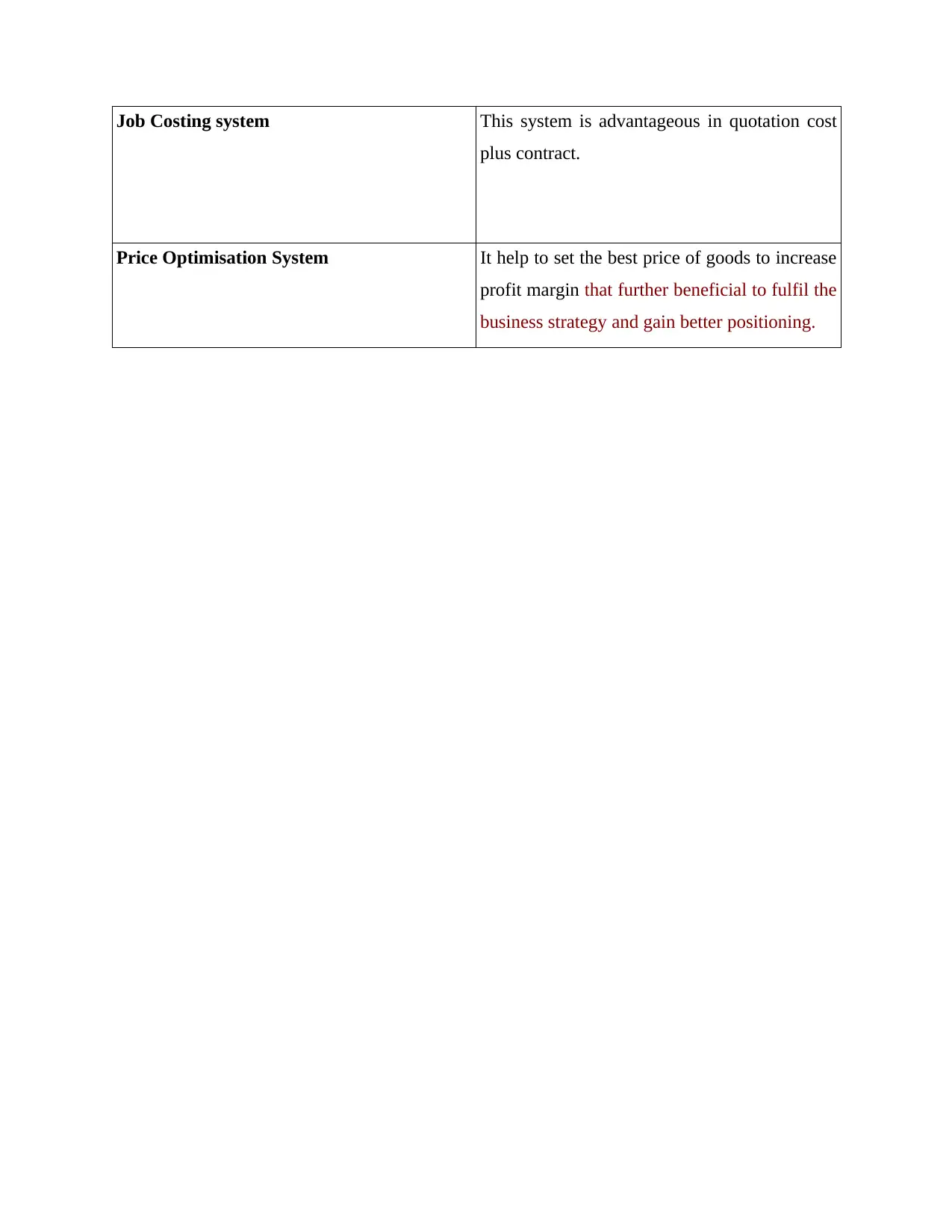
Job Costing system This system is advantageous in quotation cost
plus contract.
Price Optimisation System It help to set the best price of goods to increase
profit margin that further beneficial to fulfil the
business strategy and gain better positioning.
plus contract.
Price Optimisation System It help to set the best price of goods to increase
profit margin that further beneficial to fulfil the
business strategy and gain better positioning.
⊘ This is a preview!⊘
Do you want full access?
Subscribe today to unlock all pages.

Trusted by 1+ million students worldwide
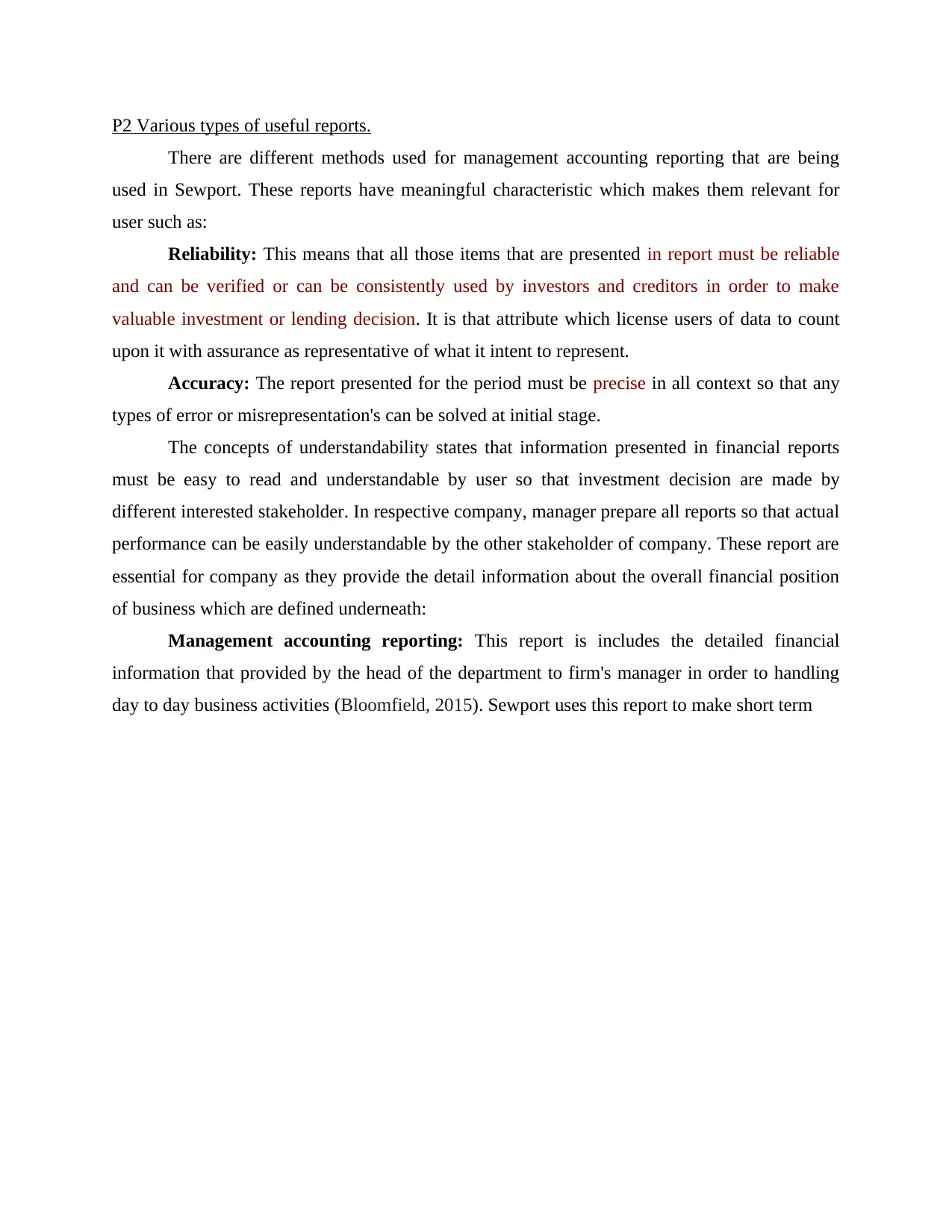
P2 Various types of useful reports.
There are different methods used for management accounting reporting that are being
used in Sewport. These reports have meaningful characteristic which makes them relevant for
user such as:
Reliability: This means that all those items that are presented in report must be reliable
and can be verified or can be consistently used by investors and creditors in order to make
valuable investment or lending decision. It is that attribute which license users of data to count
upon it with assurance as representative of what it intent to represent.
Accuracy: The report presented for the period must be precise in all context so that any
types of error or misrepresentation's can be solved at initial stage.
The concepts of understandability states that information presented in financial reports
must be easy to read and understandable by user so that investment decision are made by
different interested stakeholder. In respective company, manager prepare all reports so that actual
performance can be easily understandable by the other stakeholder of company. These report are
essential for company as they provide the detail information about the overall financial position
of business which are defined underneath:
Management accounting reporting: This report is includes the detailed financial
information that provided by the head of the department to firm's manager in order to handling
day to day business activities (Bloomfield, 2015). Sewport uses this report to make short term
There are different methods used for management accounting reporting that are being
used in Sewport. These reports have meaningful characteristic which makes them relevant for
user such as:
Reliability: This means that all those items that are presented in report must be reliable
and can be verified or can be consistently used by investors and creditors in order to make
valuable investment or lending decision. It is that attribute which license users of data to count
upon it with assurance as representative of what it intent to represent.
Accuracy: The report presented for the period must be precise in all context so that any
types of error or misrepresentation's can be solved at initial stage.
The concepts of understandability states that information presented in financial reports
must be easy to read and understandable by user so that investment decision are made by
different interested stakeholder. In respective company, manager prepare all reports so that actual
performance can be easily understandable by the other stakeholder of company. These report are
essential for company as they provide the detail information about the overall financial position
of business which are defined underneath:
Management accounting reporting: This report is includes the detailed financial
information that provided by the head of the department to firm's manager in order to handling
day to day business activities (Bloomfield, 2015). Sewport uses this report to make short term
Paraphrase This Document
Need a fresh take? Get an instant paraphrase of this document with our AI Paraphraser
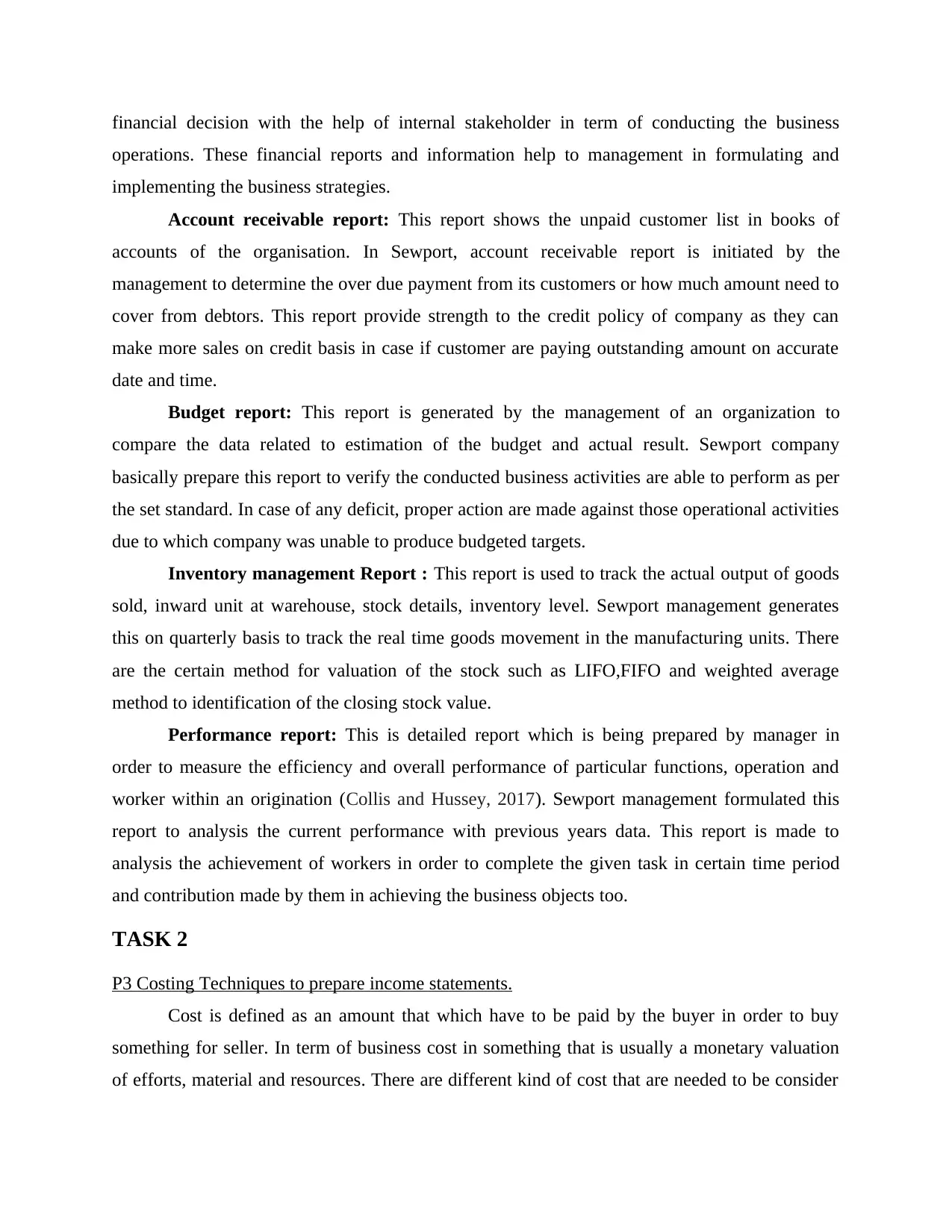
financial decision with the help of internal stakeholder in term of conducting the business
operations. These financial reports and information help to management in formulating and
implementing the business strategies.
Account receivable report: This report shows the unpaid customer list in books of
accounts of the organisation. In Sewport, account receivable report is initiated by the
management to determine the over due payment from its customers or how much amount need to
cover from debtors. This report provide strength to the credit policy of company as they can
make more sales on credit basis in case if customer are paying outstanding amount on accurate
date and time.
Budget report: This report is generated by the management of an organization to
compare the data related to estimation of the budget and actual result. Sewport company
basically prepare this report to verify the conducted business activities are able to perform as per
the set standard. In case of any deficit, proper action are made against those operational activities
due to which company was unable to produce budgeted targets.
Inventory management Report : This report is used to track the actual output of goods
sold, inward unit at warehouse, stock details, inventory level. Sewport management generates
this on quarterly basis to track the real time goods movement in the manufacturing units. There
are the certain method for valuation of the stock such as LIFO,FIFO and weighted average
method to identification of the closing stock value.
Performance report: This is detailed report which is being prepared by manager in
order to measure the efficiency and overall performance of particular functions, operation and
worker within an origination (Collis and Hussey, 2017). Sewport management formulated this
report to analysis the current performance with previous years data. This report is made to
analysis the achievement of workers in order to complete the given task in certain time period
and contribution made by them in achieving the business objects too.
TASK 2
P3 Costing Techniques to prepare income statements.
Cost is defined as an amount that which have to be paid by the buyer in order to buy
something for seller. In term of business cost in something that is usually a monetary valuation
of efforts, material and resources. There are different kind of cost that are needed to be consider
operations. These financial reports and information help to management in formulating and
implementing the business strategies.
Account receivable report: This report shows the unpaid customer list in books of
accounts of the organisation. In Sewport, account receivable report is initiated by the
management to determine the over due payment from its customers or how much amount need to
cover from debtors. This report provide strength to the credit policy of company as they can
make more sales on credit basis in case if customer are paying outstanding amount on accurate
date and time.
Budget report: This report is generated by the management of an organization to
compare the data related to estimation of the budget and actual result. Sewport company
basically prepare this report to verify the conducted business activities are able to perform as per
the set standard. In case of any deficit, proper action are made against those operational activities
due to which company was unable to produce budgeted targets.
Inventory management Report : This report is used to track the actual output of goods
sold, inward unit at warehouse, stock details, inventory level. Sewport management generates
this on quarterly basis to track the real time goods movement in the manufacturing units. There
are the certain method for valuation of the stock such as LIFO,FIFO and weighted average
method to identification of the closing stock value.
Performance report: This is detailed report which is being prepared by manager in
order to measure the efficiency and overall performance of particular functions, operation and
worker within an origination (Collis and Hussey, 2017). Sewport management formulated this
report to analysis the current performance with previous years data. This report is made to
analysis the achievement of workers in order to complete the given task in certain time period
and contribution made by them in achieving the business objects too.
TASK 2
P3 Costing Techniques to prepare income statements.
Cost is defined as an amount that which have to be paid by the buyer in order to buy
something for seller. In term of business cost in something that is usually a monetary valuation
of efforts, material and resources. There are different kind of cost that are needed to be consider
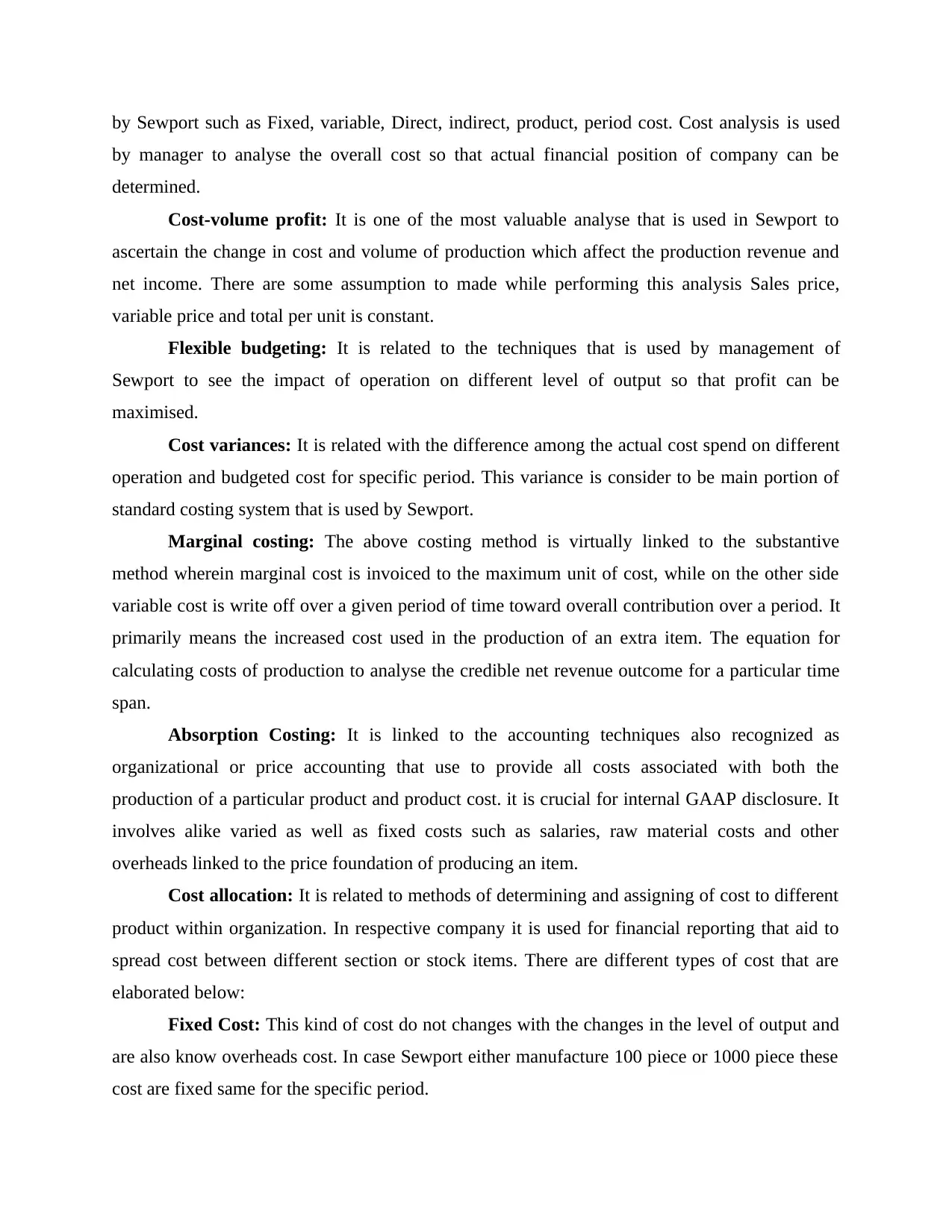
by Sewport such as Fixed, variable, Direct, indirect, product, period cost. Cost analysis is used
by manager to analyse the overall cost so that actual financial position of company can be
determined.
Cost-volume profit: It is one of the most valuable analyse that is used in Sewport to
ascertain the change in cost and volume of production which affect the production revenue and
net income. There are some assumption to made while performing this analysis Sales price,
variable price and total per unit is constant.
Flexible budgeting: It is related to the techniques that is used by management of
Sewport to see the impact of operation on different level of output so that profit can be
maximised.
Cost variances: It is related with the difference among the actual cost spend on different
operation and budgeted cost for specific period. This variance is consider to be main portion of
standard costing system that is used by Sewport.
Marginal costing: The above costing method is virtually linked to the substantive
method wherein marginal cost is invoiced to the maximum unit of cost, while on the other side
variable cost is write off over a given period of time toward overall contribution over a period. It
primarily means the increased cost used in the production of an extra item. The equation for
calculating costs of production to analyse the credible net revenue outcome for a particular time
span.
Absorption Costing: It is linked to the accounting techniques also recognized as
organizational or price accounting that use to provide all costs associated with both the
production of a particular product and product cost. it is crucial for internal GAAP disclosure. It
involves alike varied as well as fixed costs such as salaries, raw material costs and other
overheads linked to the price foundation of producing an item.
Cost allocation: It is related to methods of determining and assigning of cost to different
product within organization. In respective company it is used for financial reporting that aid to
spread cost between different section or stock items. There are different types of cost that are
elaborated below:
Fixed Cost: This kind of cost do not changes with the changes in the level of output and
are also know overheads cost. In case Sewport either manufacture 100 piece or 1000 piece these
cost are fixed same for the specific period.
by manager to analyse the overall cost so that actual financial position of company can be
determined.
Cost-volume profit: It is one of the most valuable analyse that is used in Sewport to
ascertain the change in cost and volume of production which affect the production revenue and
net income. There are some assumption to made while performing this analysis Sales price,
variable price and total per unit is constant.
Flexible budgeting: It is related to the techniques that is used by management of
Sewport to see the impact of operation on different level of output so that profit can be
maximised.
Cost variances: It is related with the difference among the actual cost spend on different
operation and budgeted cost for specific period. This variance is consider to be main portion of
standard costing system that is used by Sewport.
Marginal costing: The above costing method is virtually linked to the substantive
method wherein marginal cost is invoiced to the maximum unit of cost, while on the other side
variable cost is write off over a given period of time toward overall contribution over a period. It
primarily means the increased cost used in the production of an extra item. The equation for
calculating costs of production to analyse the credible net revenue outcome for a particular time
span.
Absorption Costing: It is linked to the accounting techniques also recognized as
organizational or price accounting that use to provide all costs associated with both the
production of a particular product and product cost. it is crucial for internal GAAP disclosure. It
involves alike varied as well as fixed costs such as salaries, raw material costs and other
overheads linked to the price foundation of producing an item.
Cost allocation: It is related to methods of determining and assigning of cost to different
product within organization. In respective company it is used for financial reporting that aid to
spread cost between different section or stock items. There are different types of cost that are
elaborated below:
Fixed Cost: This kind of cost do not changes with the changes in the level of output and
are also know overheads cost. In case Sewport either manufacture 100 piece or 1000 piece these
cost are fixed same for the specific period.
⊘ This is a preview!⊘
Do you want full access?
Subscribe today to unlock all pages.

Trusted by 1+ million students worldwide
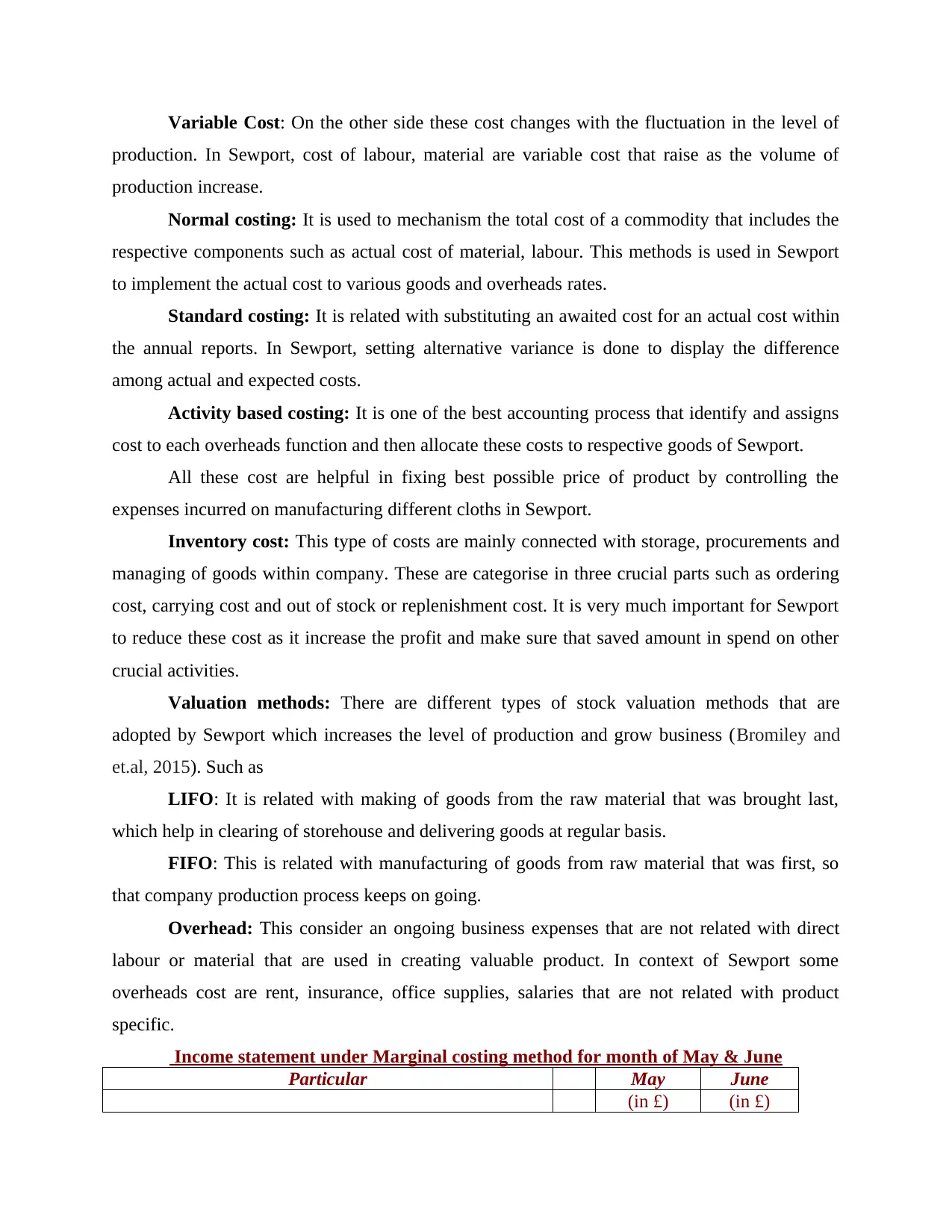
Variable Cost: On the other side these cost changes with the fluctuation in the level of
production. In Sewport, cost of labour, material are variable cost that raise as the volume of
production increase.
Normal costing: It is used to mechanism the total cost of a commodity that includes the
respective components such as actual cost of material, labour. This methods is used in Sewport
to implement the actual cost to various goods and overheads rates.
Standard costing: It is related with substituting an awaited cost for an actual cost within
the annual reports. In Sewport, setting alternative variance is done to display the difference
among actual and expected costs.
Activity based costing: It is one of the best accounting process that identify and assigns
cost to each overheads function and then allocate these costs to respective goods of Sewport.
All these cost are helpful in fixing best possible price of product by controlling the
expenses incurred on manufacturing different cloths in Sewport.
Inventory cost: This type of costs are mainly connected with storage, procurements and
managing of goods within company. These are categorise in three crucial parts such as ordering
cost, carrying cost and out of stock or replenishment cost. It is very much important for Sewport
to reduce these cost as it increase the profit and make sure that saved amount in spend on other
crucial activities.
Valuation methods: There are different types of stock valuation methods that are
adopted by Sewport which increases the level of production and grow business (Bromiley and
et.al, 2015). Such as
LIFO: It is related with making of goods from the raw material that was brought last,
which help in clearing of storehouse and delivering goods at regular basis.
FIFO: This is related with manufacturing of goods from raw material that was first, so
that company production process keeps on going.
Overhead: This consider an ongoing business expenses that are not related with direct
labour or material that are used in creating valuable product. In context of Sewport some
overheads cost are rent, insurance, office supplies, salaries that are not related with product
specific.
Income statement under Marginal costing method for month of May & June
Particular May June
(in £) (in £)
production. In Sewport, cost of labour, material are variable cost that raise as the volume of
production increase.
Normal costing: It is used to mechanism the total cost of a commodity that includes the
respective components such as actual cost of material, labour. This methods is used in Sewport
to implement the actual cost to various goods and overheads rates.
Standard costing: It is related with substituting an awaited cost for an actual cost within
the annual reports. In Sewport, setting alternative variance is done to display the difference
among actual and expected costs.
Activity based costing: It is one of the best accounting process that identify and assigns
cost to each overheads function and then allocate these costs to respective goods of Sewport.
All these cost are helpful in fixing best possible price of product by controlling the
expenses incurred on manufacturing different cloths in Sewport.
Inventory cost: This type of costs are mainly connected with storage, procurements and
managing of goods within company. These are categorise in three crucial parts such as ordering
cost, carrying cost and out of stock or replenishment cost. It is very much important for Sewport
to reduce these cost as it increase the profit and make sure that saved amount in spend on other
crucial activities.
Valuation methods: There are different types of stock valuation methods that are
adopted by Sewport which increases the level of production and grow business (Bromiley and
et.al, 2015). Such as
LIFO: It is related with making of goods from the raw material that was brought last,
which help in clearing of storehouse and delivering goods at regular basis.
FIFO: This is related with manufacturing of goods from raw material that was first, so
that company production process keeps on going.
Overhead: This consider an ongoing business expenses that are not related with direct
labour or material that are used in creating valuable product. In context of Sewport some
overheads cost are rent, insurance, office supplies, salaries that are not related with product
specific.
Income statement under Marginal costing method for month of May & June
Particular May June
(in £) (in £)
Paraphrase This Document
Need a fresh take? Get an instant paraphrase of this document with our AI Paraphraser
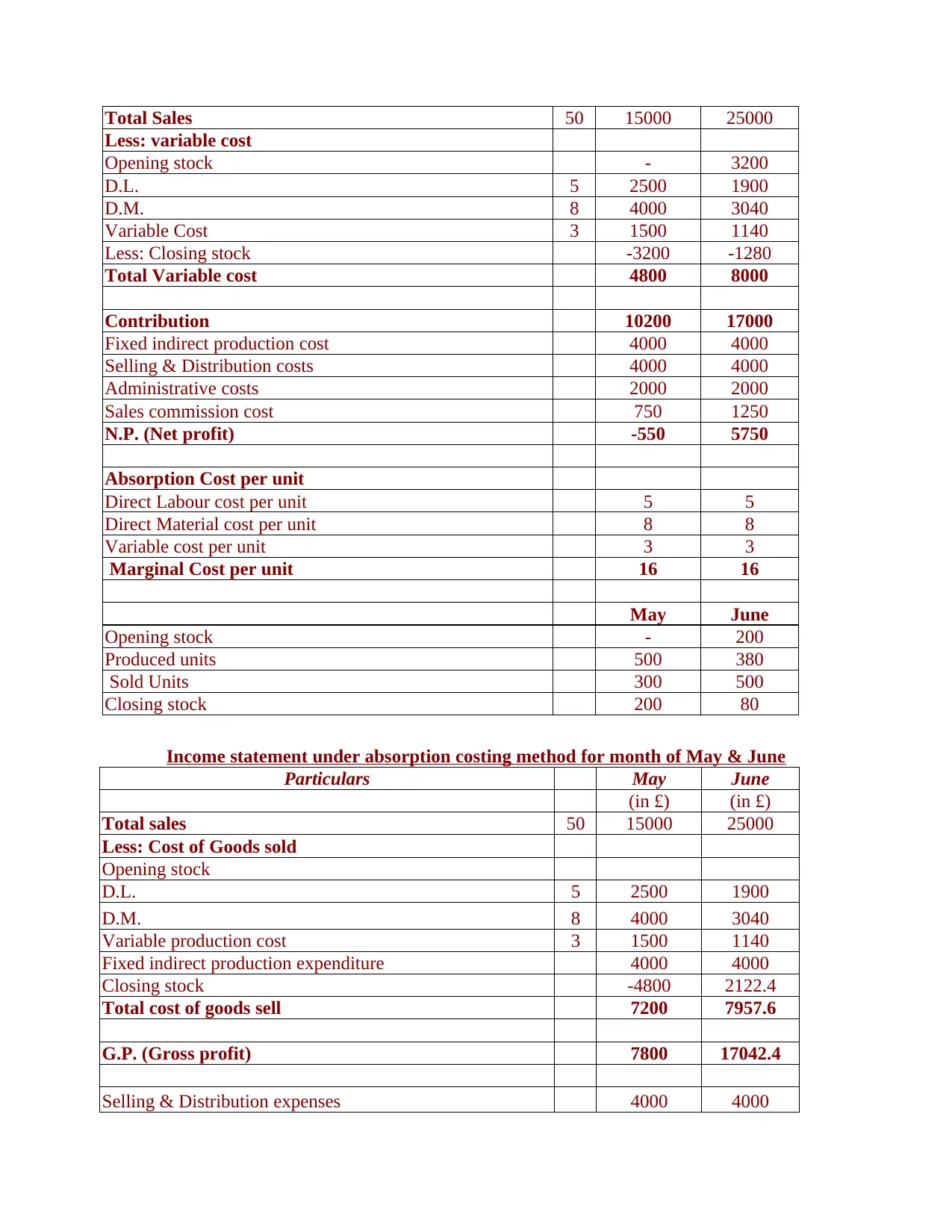
Total Sales 50 15000 25000
Less: variable cost
Opening stock - 3200
D.L. 5 2500 1900
D.M. 8 4000 3040
Variable Cost 3 1500 1140
Less: Closing stock -3200 -1280
Total Variable cost 4800 8000
Contribution 10200 17000
Fixed indirect production cost 4000 4000
Selling & Distribution costs 4000 4000
Administrative costs 2000 2000
Sales commission cost 750 1250
N.P. (Net profit) -550 5750
Absorption Cost per unit
Direct Labour cost per unit 5 5
Direct Material cost per unit 8 8
Variable cost per unit 3 3
Marginal Cost per unit 16 16
May June
Opening stock - 200
Produced units 500 380
Sold Units 300 500
Closing stock 200 80
Income statement under absorption costing method for month of May & June
Particulars May June
(in £) (in £)
Total sales 50 15000 25000
Less: Cost of Goods sold
Opening stock
D.L. 5 2500 1900
D.M. 8 4000 3040
Variable production cost 3 1500 1140
Fixed indirect production expenditure 4000 4000
Closing stock -4800 2122.4
Total cost of goods sell 7200 7957.6
G.P. (Gross profit) 7800 17042.4
Selling & Distribution expenses 4000 4000
Less: variable cost
Opening stock - 3200
D.L. 5 2500 1900
D.M. 8 4000 3040
Variable Cost 3 1500 1140
Less: Closing stock -3200 -1280
Total Variable cost 4800 8000
Contribution 10200 17000
Fixed indirect production cost 4000 4000
Selling & Distribution costs 4000 4000
Administrative costs 2000 2000
Sales commission cost 750 1250
N.P. (Net profit) -550 5750
Absorption Cost per unit
Direct Labour cost per unit 5 5
Direct Material cost per unit 8 8
Variable cost per unit 3 3
Marginal Cost per unit 16 16
May June
Opening stock - 200
Produced units 500 380
Sold Units 300 500
Closing stock 200 80
Income statement under absorption costing method for month of May & June
Particulars May June
(in £) (in £)
Total sales 50 15000 25000
Less: Cost of Goods sold
Opening stock
D.L. 5 2500 1900
D.M. 8 4000 3040
Variable production cost 3 1500 1140
Fixed indirect production expenditure 4000 4000
Closing stock -4800 2122.4
Total cost of goods sell 7200 7957.6
G.P. (Gross profit) 7800 17042.4
Selling & Distribution expenses 4000 4000

Administrative cost 2000 2000
Sales commission expenditure 750 1250
N.P. (Net profit) 1050 9792.4
Absorption Cost per unit
Direct labour cost per unit 5 5
Direct material cost per unit 8 8
Variable cost per unit 3 3
Fixed indirect production expenses per unit 8 10.53
Total Absorption Cost per unit 24 26.53
May June
Opening stock - 200
Units produced 500 380
Sold units 300 500
Closing stock 200 80
Valuation of closing stock using LIFO
Date Reference Purchase Issues Balance (Inventory)
Units £/Units £ Total Units £/Units £ Total Units £/Units £ Total
05/01 Previous balance
(inventory) 40 3.00 120.00
05/12 40 3.00 120.00
Bought 25 units
at £ 3.60 each 20 3.60 72. 20 3.60 72.00
05/15 20 3.60 72.
Issued 36 units 16 3.00 48. 24 3.00 72.00
05/20 24 3.00 72.00
Bought 20 units
at £ 3.75 each 20 3.75 75. 20 3.75 75.00
05/23 Issued 10 units 10 3.75 37.5 24 3.00 72.00
10 3.75 37.50
05/27 9 3.75 33.75
Issued 25 units 25 3.00 75.00
05/30 Issued 5 units 5 3.00 15.00 4 3.75 15.00
Valuation of closing stock by using weighted average method:
05/01 Previous balance
(inventory) 40 3.0000 120.0000
05/12 Bought 25 units at £
3.60 each 25 3.60 90. 65 3.2308 210.0000
05/15 Issued 36 units 36 3.2308 116.307
7 29 3.2308 93.6923
05/20 Bought 20 units at £
3.75 each 20 3.75 75. 49 3.4427 168.6923
05/23 Issued 10 units 10 3.4427 34.4270 39 3.4427 134.2653
Sales commission expenditure 750 1250
N.P. (Net profit) 1050 9792.4
Absorption Cost per unit
Direct labour cost per unit 5 5
Direct material cost per unit 8 8
Variable cost per unit 3 3
Fixed indirect production expenses per unit 8 10.53
Total Absorption Cost per unit 24 26.53
May June
Opening stock - 200
Units produced 500 380
Sold units 300 500
Closing stock 200 80
Valuation of closing stock using LIFO
Date Reference Purchase Issues Balance (Inventory)
Units £/Units £ Total Units £/Units £ Total Units £/Units £ Total
05/01 Previous balance
(inventory) 40 3.00 120.00
05/12 40 3.00 120.00
Bought 25 units
at £ 3.60 each 20 3.60 72. 20 3.60 72.00
05/15 20 3.60 72.
Issued 36 units 16 3.00 48. 24 3.00 72.00
05/20 24 3.00 72.00
Bought 20 units
at £ 3.75 each 20 3.75 75. 20 3.75 75.00
05/23 Issued 10 units 10 3.75 37.5 24 3.00 72.00
10 3.75 37.50
05/27 9 3.75 33.75
Issued 25 units 25 3.00 75.00
05/30 Issued 5 units 5 3.00 15.00 4 3.75 15.00
Valuation of closing stock by using weighted average method:
05/01 Previous balance
(inventory) 40 3.0000 120.0000
05/12 Bought 25 units at £
3.60 each 25 3.60 90. 65 3.2308 210.0000
05/15 Issued 36 units 36 3.2308 116.307
7 29 3.2308 93.6923
05/20 Bought 20 units at £
3.75 each 20 3.75 75. 49 3.4427 168.6923
05/23 Issued 10 units 10 3.4427 34.4270 39 3.4427 134.2653
⊘ This is a preview!⊘
Do you want full access?
Subscribe today to unlock all pages.

Trusted by 1+ million students worldwide
1 out of 23
Related Documents
Your All-in-One AI-Powered Toolkit for Academic Success.
+13062052269
info@desklib.com
Available 24*7 on WhatsApp / Email
![[object Object]](/_next/static/media/star-bottom.7253800d.svg)
Unlock your academic potential
Copyright © 2020–2025 A2Z Services. All Rights Reserved. Developed and managed by ZUCOL.





